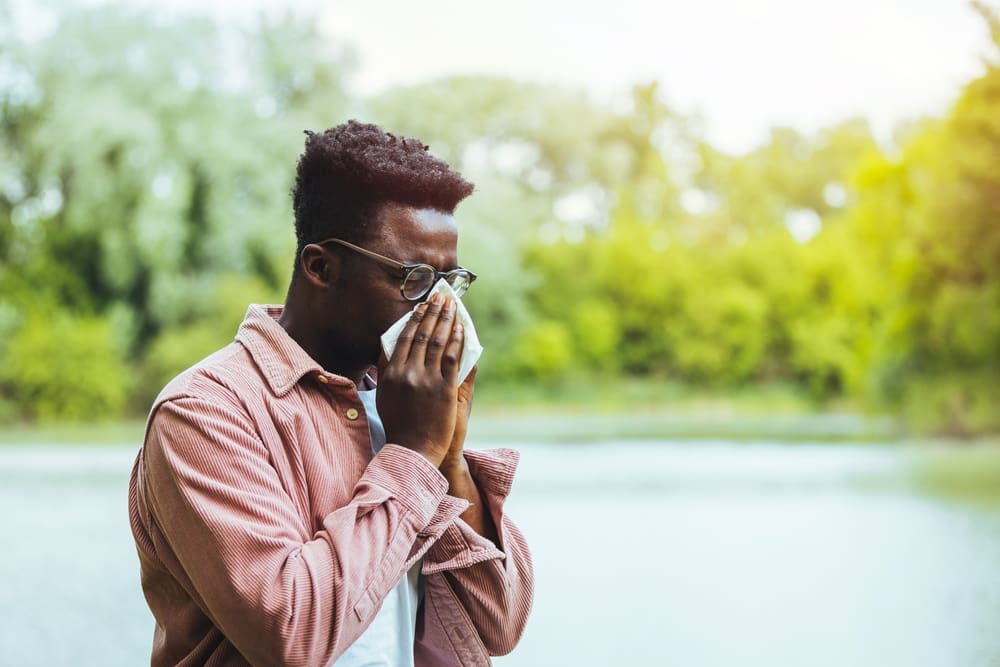That innocent-looking allergy pill promising to rescue you from the pollen apocalypse might be doing more than just drying up your runny nose. While you’re focused on stopping the sneezing marathon, certain allergy medications are quietly creating other health issues that could stick around long after allergy season ends. The truth is that not all allergy treatments are created equal, and some popular options carry surprising risks that most people never hear about when grabbing them off the pharmacy shelf.
With over a quarter of Americans battling seasonal allergies, millions are popping pills and spraying their nostrils daily without fully understanding the tradeoffs they’re making. Let’s pull back the curtain on what your allergy medications are really doing inside your body, and explore which options offer relief without the concerning side effects that might make you think twice about your go-to allergy remedy.
Nasal steroid sprays work magic but have a ticking clock
Those nasal steroid sprays like Flonase and Nasacort sitting in your medicine cabinet are powerhouses for controlling the full spectrum of allergy symptoms. They reduce inflammation in your nasal passages, blocking multiple allergic pathways at once instead of just addressing histamine like many pills do.
What most users don’t realize is that these sprays come with an unwritten expiration date on how long you should use them continuously. While generally considered safe, using them beyond three months straight each year raises red flags for doctors. Extended use increases your risk of nasal septal perforation—literally a hole developing in the wall between your nostrils—along with more frequent nosebleeds and nasal dryness.
The steroid component also creates more serious concerns with prolonged exposure. These medications can be absorbed into your bloodstream in small amounts, potentially affecting your eyes over time. People who use nasal steroids for extended periods face higher risks of developing cataracts and glaucoma, particularly those with family histories of these conditions.
First-generation antihistamines carry surprising brain risks
That Benadryl you take to knock out your allergies might be knocking out more than just your symptoms. First-generation antihistamines like diphenhydramine cross the blood-brain barrier easily, creating that familiar drowsy feeling that many allergy sufferers have experienced.
What’s more alarming is what happens with regular, long-term use. Research has linked consistent use of these older antihistamines with an increased risk of dementia. These medications have anticholinergic effects that block acetylcholine, a neurotransmitter vital for memory and learning, potentially contributing to cognitive decline over time.
The impairment isn’t just a concern for the distant future. Even short-term use affects your cognitive performance and reaction times, similar to being legally drunk in some cases. That morning Benadryl could be impairing your driving abilities and work performance even when you don’t feel particularly sleepy.
Second-generation antihistamines hide their own problems
The newer, non-drowsy antihistamines like Claritin, Zyrtec, and Allegra were developed specifically to overcome the sedating effects of their predecessors. They generally don’t cross the blood-brain barrier as easily, making them safer options for daytime use when you need to remain alert.
However, these medications aren’t entirely without concerns. Many users report developing tolerance over time, requiring higher doses to achieve the same relief. Others experience a phenomenon called “rebound symptoms” when trying to stop taking them after extended use, particularly with Zyrtec, where itching can actually worsen temporarily upon discontinuation.
While generally considered safe for longer use than first-generation options, these medications still aren’t meant to be daily companions throughout your life. Using them only when symptoms are present rather than as preventive daily pills reduces your exposure to potential side effects while still providing relief when you need it most.
Combined decongestant formulas add cardiovascular risks
Many allergy sufferers reach for the combination products like Claritin-D or Allegra-D to tackle both allergies and congestion at once. The “D” indicates the addition of pseudoephedrine or phenylephrine, decongestants that shrink swollen nasal passages by constricting blood vessels.
This vessel-narrowing action doesn’t just happen in your nose—it occurs throughout your body. The result can be elevated blood pressure, increased heart rate, and even heart rhythm disturbances in susceptible individuals. For people with existing heart conditions, high blood pressure, or anxiety disorders, these combination medications can turn allergy relief into a cardiac stress test.
The stimulant properties also frequently cause insomnia, nervousness, and irritability. Many users find themselves caught in a cycle of taking nighttime medications to counteract the stimulating effects of their daytime allergy pills, creating a medication merry-go-round that’s difficult to exit.
Leukotriene modifiers bring psychiatric surprises
Prescription options like montelukast, marketed as Singulair, block an entirely different pathway involved in allergic reactions. These medications target leukotrienes, inflammatory compounds that trigger allergy and asthma symptoms, and work well for people who haven’t found relief with other treatments.
What many patients aren’t adequately warned about is the potential for psychiatric side effects. The FDA has strengthened warnings about mental health side effects associated with montelukast, including agitation, depression, sleep problems, and suicidal thoughts. These effects have been particularly concerning in children, leading many allergists to reconsider prescribing these medications as first-line treatments.
While the majority of users don’t experience these severe side effects, the risk is significant enough that the FDA now requires a boxed warning—their strongest safety alert—on these medications. Anyone taking leukotriene modifiers should be monitored closely for mood or behavior changes, especially during the first weeks of treatment.
Natural approaches that actually work
If the potential side effects of medications have you concerned, several evidence-backed natural approaches can significantly reduce your allergy burden without pharmaceutical intervention. These strategies focus on reducing your exposure to allergens rather than blocking your body’s reaction to them.
Nasal irrigation with saline solution physically flushes allergens from your nasal passages before they can trigger symptoms. Using a neti pot or saline spray immediately after outdoor exposure can wash away up to 90% of pollen and other allergens before they cause problems. This simple practice, when done regularly, can reduce both symptoms and reliance on medications.
Air purifiers with HEPA filters capture the microscopic pollen, dust, and mold particles that trigger allergies. Placing units in bedrooms creates an allergen-free sleep sanctuary that can drastically improve symptoms overnight. The investment pays dividends in reduced medication needs and better sleep quality during allergy season.
Local honey contains trace amounts of local pollen and may help desensitize your system over time, similar to allergy immunotherapy but through a natural approach. While scientific evidence remains mixed, many allergy sufferers report improved symptoms after incorporating local, unfiltered honey into their daily routine for several months before allergy season.
The clothing change ritual few people practice
One of the most effective yet overlooked allergy management strategies costs nothing but requires changing a habitual behavior. Pollen clings tenaciously to clothing, hair, and skin, continuing to trigger symptoms long after you’ve come indoors.
Implementing a “clean room” approach to your bedroom by changing clothes immediately upon returning home and showering before bed removes these hidden allergens. Your hair particularly acts like a pollen magnet, depositing allergens onto your pillow where you then breathe them in all night long.
This simple practice creates at least one pollen-free zone in your life, giving your immune system regular breaks from constant allergen exposure. Many allergy sufferers find this strategy alone reduces their symptoms enough to decrease medication dependence during peak pollen seasons.
When to upgrade to immunotherapy
If you’ve tried multiple medications and natural approaches without adequate relief, or if allergies significantly impact your quality of life for multiple months each year, it may be time to consider the only treatment that actually addresses the cause of allergies rather than just masking symptoms.
Immunotherapy, available as subcutaneous injections or sublingual tablets, gradually retrains your immune system to stop overreacting to harmless substances like pollen. Unlike medications that provide temporary relief, immunotherapy can create lasting changes in your immune response, often resulting in permanent reduction or elimination of allergy symptoms.
The treatment typically takes 3-5 years to complete, but many patients experience significant improvement within the first year. While the time commitment exceeds that of simply taking pills, the potential for long-term cure rather than endless symptom management makes immunotherapy the most cost-effective and body-friendly option for severe allergy sufferers.
Creating your personalized allergy battle plan
The most effective approach to seasonal allergies typically combines strategic medication use with environmental management. Rather than reaching for the same allergy pill year after year, consider developing a more sophisticated approach that minimizes both symptoms and side effects.
Reserve nasal steroid sprays for your worst allergy months, using them consistently for maximum effectiveness but discontinuing after the peak season passes. Add second-generation antihistamines only on days when symptoms break through despite the nasal spray, rather than taking them preventively.
Implement a graduated response to symptoms, starting with natural approaches like saline irrigation and adding medications only as needed based on symptom severity. This thoughtful approach provides relief while minimizing your exposure to potential medication side effects.
Track local pollen counts using smartphone apps and plan outdoor activities strategically during lower pollen periods. Simple timing adjustments like exercising in the evening instead of morning can dramatically reduce symptom severity and medication needs during peak pollen season.
The seasonal allergy battle doesn’t have a one-size-fits-all solution, but understanding the true benefits and risks of each treatment option empowers you to make choices that provide relief without unwanted consequences. With thoughtful management, you can breathe easier knowing you’re addressing your symptoms in the smartest way possible.

















